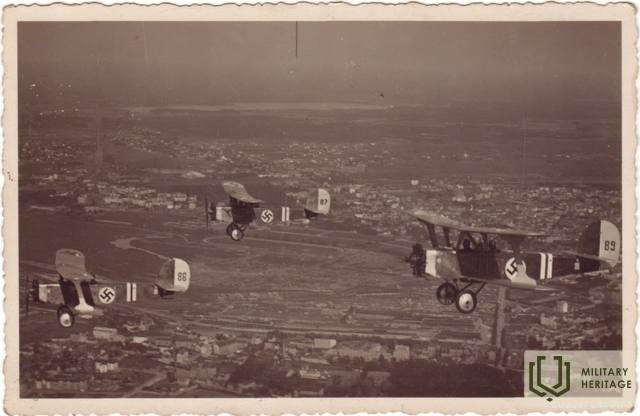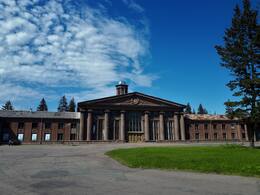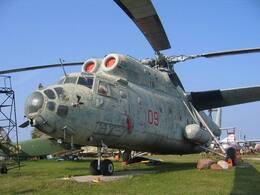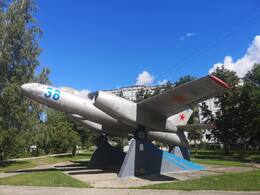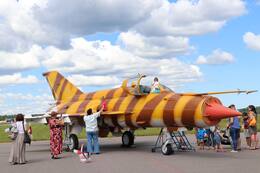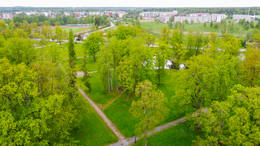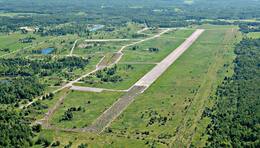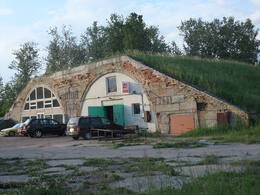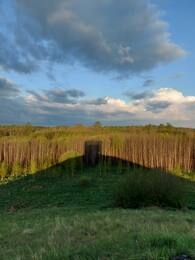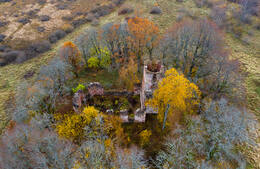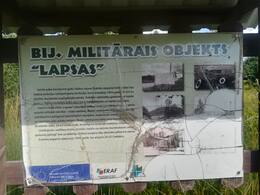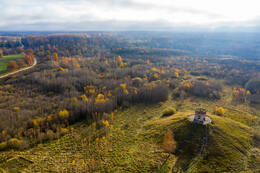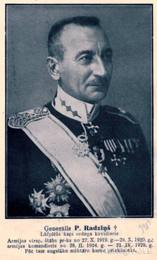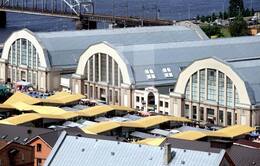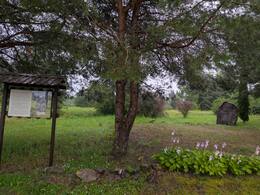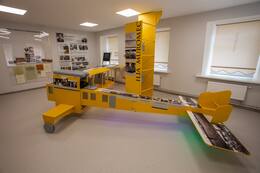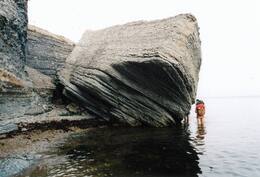Karinė aviacija
I WW1, I Nepriklausomybės karai, Baltijos šalių nepriklausomybė, II Antrasis pasaulinis karas, IV Sovietų okupacija, Atkurta Nepriklausomybė

Po Latvijos valstybės paskelbimo 1918 m. gruodžio pradžioje prasidėjo Latvijos ginkluotųjų pajėgų formavimas.
1919 m. birželio 7 d. buvo įkurtas Latvijos ginkluotųjų pajėgų aviacijos parkas (šūkis – „Viskas Latvijai!“), kurio pirmuoju vadu tapo Alfredas Valeika. 1921 m. Aviacijos parkas buvo pertvarkytas į Aviacijos diviziją, o 1926 m. rugsėjo 18 d. – į Aviacijos pulką.
Nuo 1919 iki 1940 metų Latvijos karinė aviacija tapo stipriausia Baltijos šalyse. Tuo metu Latvijos aviacija turėjo lėktuvus, pagamintus savo gamykloje VEF ir Liepojos karinio uosto dirbtuvėse. Taip pat buvo lėktuvų iš Europos, daugiausia iš Anglijos. Aviacijos pulką sudarė naikintuvų eskadrilės, žvalgybinių lėktuvų eskadrilės, jūrų aviacijos eskadrilė ir aviacijos mokyklos padalinys, kuris rengė pilotus ir specialistus visoms būtinoms tarnyboms. 1939 metais Aviacijos pulką sudarė: pulko štabas Rygoje, 8 operaciniai eskadrilės (60 lėktuvų, 120 pilotų ir 80 specialistų), Karo aviacijos mokykla, remonto dirbtuvės ir tiekimo sandėlis.
Aviacijos pulkas oficialiai nustojo egzistuoti 1940 m. gruodžio 25 d., SSRS okupavus Latviją.
Latvijai atgavus nepriklausomybę, pradėtas ir Latvijos gynybos pajėgų atkūrimas. 1992 m. vasario 24 d. Gynybos pajėgų štabe buvo įkurta Oro ir priešlėktuvinės gynybos direkcija, kuri vėliau buvo pertvarkyta į Karinių oro pajėgų štabą. 1992 m. birželio 17 d. gynybos ministras pasirašė įsakymą dėl Karinių oro pajėgų atkūrimo.
Daugiau informacijos šaltinių
Šaltiniai:
https://www.mil.lv/lv/vienibas/gaisa-speki
Susijusios vietos
Pagalvės oro uostas
Įsikūręs Rygoje, Pārdaugavoje, Spilvės pievose netoli Iļģuciems.
Spilvė karinio paveldo istorijoje garsėja grandioziniu Spilvės mūšiu XVIII a. ir Spilvės aerodromu. Nuo XX a. ji buvo naudojama lėktuvams bandyti, tačiau Pirmojo pasaulinio karo metu tapo Latvijos aviacijos istorijos liudininku.
Pirmojo pasaulinio karo metu Spilvės pievas Rusijos armijos oro pajėgos naudojo kovai su Vokietijos armija. Sukūrus Latviją, aerodromas tapo svarbiausia šalies oro pajėgų baze ir pilotų mokymo aikštele. Ankstesni aerodromo pavadinimai buvo „Spilvės oro uostas“ arba „Rygos oro uostas“, vėliau „Rygos centrinis oro uostas“. Tai buvo pagrindinis Latvijos oro uostas iki „Rygos“ oro uosto atidarymo 1975 m.
Galbūt Spilvės aerodromas netoli Rygos ir svajonė siekti žvaigždžių prisidėjo prie įspūdingų daugelio Latvijos pilotų pasiekimų. Tačiau galbūt Latvijos aviacijos pradžia yra daug senesnė ir siekia Priekulę, kur latvių kalvis Zviedris savadarbiu prietaisu atliko skrydį iš bažnyčios bokšto.
Šiandien Spilvės aerodromas veikia vis dar. Galima pamatyti 1954 m. pastatytą oro uosto pastatą, kuris įkūnija sovietinį klasicizmą arba „Stalino imperijos“ stilių.
Šaltiniai:
Irbītis, K. Latvijos aviacija ir jos pradininkai. Ryga: Zinātne, 2004 m.
Brūvelis, E. Latvijos aviacijos istorija: 1919-1940. Ryga: Zinātne, 2003 m.
Oficiali valstybinės agentūros „Civilinės aviacijos agentūra“ svetainė. Prieiga per internetą: https://www.caa.gov.lv/lv/latvijas-aviacijas-vesture-isuma [žiūrėta 2021-02-22].
Rygos oro muziejus (Rygos aviacijos muziejus)
Rygos aviacijos muziejus yra Skultės kaime, Marupės savivaldybėje, Rygos oro uosto teritorijoje, šalia orlaivių stebėjimo aikštelės. Tai privatus turistinis objektas, atidarytas 1997 m. Šiai kolekcijai sukurti prireikė daugiau nei 50 metų. Aviacijos įranga surinkta iš Latvijos, Rusijos, Lenkijos, Ukrainos, Čekijos ir JAV. Tai viena didžiausių ir vertingiausių kolekcijų Europoje. Latvijos aviacijos muziejaus idėja kilo mažiausiai prieš 80 metų. Latvijos aviacijos istorija siekia laikus, kai buvo kuriami pirmieji pasaulyje orlaiviai. Latvijos pilotai buvo tarp tų, kurie dalyvavo siekiant daugelio pasaulio rekordų. Po Pirmojo pasaulinio karo ir Latvijos nepriklausomybės karo Latvijos armija pradėjo formuoti oro pajėgas, todėl iškilo poreikis išsaugoti istorinius įrodymus. Ketvirtajame dešimtmetyje atsirado galimybė pradėti kurti muziejų. Jis jau buvo įgijęs ypač vertingų istorinių eksponatų savo kolekcijoje. Antrasis pasaulinis karas sužlugdė šį projektą ir kolekcija buvo prarasta. Šiandien muziejuje yra apie 40 orlaivių, daugiausia pagamintų Sovietų Sąjungoje. O ekspozicija suteikia įžvalgų apie sovietinės aviacijos istoriją.
IL-28 orlaivio skulptūra
Įsikūręs Skultės kaime, Marupe savivaldybėje, netoli Rygos tarptautinio oro uosto.
Skultė buvo vienas iš pavyzdinių kaimų, sukurtų sovietų kariškiams. Jame buvo dislokuotas aviacijos dalinys, kuris 1941 m. bombardavo Berlyną ir kitus miestus, taip pat dalyvavo Baltijos šalių okupacijoje. 1978 m. jame buvo įrengtas aplinkosaugos objektas – lėktuvas IL-28, skirtas pagerbti sovietų armijos pilotų nuopelnus Antrajame pasauliniame kare.
Po karo Sovietų Sąjunga tęsė aktyvią ginkluotės politiką. IL-28 buvo pirmasis, plačiausiai gaminamas sovietinis reaktyvinis bombonešis. Pirmoji serijinė atominė bomba RDS-4 („Tatjana“) buvo pagaminta iš to paties modelio 1953 m., siekiant patikrinti armijos gebėjimą pradėti ataką po branduolinio sprogimo. Lėktuvas turėjo įvairių modifikacijų. Bandymų metu jis pasiekė 906 km/h greitį, gabeno kelias tonas krovinio ir atliko 2445 km skrydį. Jį pilotavo 3 žmonių įgula.
Lėktuvas yra ne tik karinio paveldo liudininkas, bet ir ideologijos simbolis. 2010 m., minint Sovietų armijos pergalę prieš Vokietiją, lėktuvas buvo restauruotas. Taip pat buvo keletas nesėkmingų bandymų jį išardyti kaip objektą, šlovinantį Latvijos okupacinį režimą. Tai pavyko 2022 m., kai lėktuvas buvo perkeltas.
Šiuo metu orlaivį galima apžiūrėti netoliese esančiame Rygos aviacijos muziejuje Skultėje, taip pat susidaryti vaizdą apie sovietinės armijos kariškiams pastatytą kaimelį.
Aviacijos muziejus „SKY ZOO“
Aviacijos muziejus „Sky Zoo“ yra Smārdės valsčiuje, Tukumo savivaldybėje, Jūrmalos oro uosto teritorijoje, kuri anksčiau buvo Tukumo karinis aerodromas. Ekspozicijoje eksponuojami lėktuvai YAK-40, AN-2, SU22M4, PZL TS-11 Iskra ir sraigtasparnis MI-24. Ekskursijos po aerodromą metu apžiūrimi angarai, kaponieriai ir inžinerinė įranga. Aerodromą naudojo tiek Vokietijos, tiek Sovietų Sąjungos armijos. Sovietų okupacijos metu tai buvo vienas svarbiausių karinių aerodromų Latvijos teritorijoje. Jame dislokuoti naikintuvai buvo skirti atakuoti priešo laivus ir bombarduoti pakrantės įtvirtinimus. 1975 m. lapkričio 9 d. naktį Tukumo aerodrome buvo gautas kovos signalas – Sovietų Sąjungos teritoriniuose vandenyse (Rygos įlankoje) buvo priešo karo laivas, kurį reikėjo sunaikinti. Iš Tukumo pakilo keli lėktuvai. Tačiau paaiškėjo, kad ginkluotas maištas prieš esamą sovietų režimą įvyko sovietų karinio jūrų laivyno karo laive „Storoževoi“ („Globėjas“). Lėktuvams pasiekus karo laivą, mūšis dar tęsėsi. Vėliau sukilėlių vadas Valerijus Sablinas, sovietų karinio jūrų laivyno karininkas, buvo sužeistas, o maištas baigėsi. Jam buvo skirta mirties bausmė už išdavystę. Tai buvo vienas dramatiškiausių įvykių, rodančių nepasitenkinimą režimu ir žyminčių artėjantį jo žlugimą.
Latvijos karinės aviacijos oro uostas
Įsikūręs Vecgulbenės dvaro teritorijoje – istoriniame centre.
Tarpukariu Gulbenėje buvo įsikūręs Latvijos armijos garnizonas, kuriame buvo dislokuotas 7-asis Siguldos pėstininkų pulko batalionas. Ketvirtojo dešimtmečio viduryje pradėta kurti karinė aviacijos bazė, nes sėkmingam karinės aviacijos veikimui net taikos metu turi būti užtikrintas platus aerodromų tinklas. Aerodromai ypač svarbūs tose vietose, kur įkurtos svarbios geležinkelio ir kelių sankryžos. 1935 m. lapkričio 11 d. čia pradėtas karinio aerodromo statymas. 1937 m. Gulbenėje buvo dislokuotas naujai suformuotas Aviacijos pulko dalinys, kuris tapo 6-uoju Latgalos divizijos žvalgybos eskadrile, padidindamas armijos dalinių skaičių prie rytinės Latvijos sienos.
Matosi oranžerijos pastatas.
Vainodės oro bazė
Vainodės aerodrome vis dar yra 16 sovietmečio orlaivių angarų ir 1800 m ilgio kadaise 2500 m ilgio tako atkarpa. Aerodromą galima aplankyti tik iš anksto užsiregistravus. Vainodės aerodromas buvo įkurtas Latvijos nepriklausomybės metais kaip vienas iš Latvijos aviacijos lopšių, o vėliau tapo vienu didžiausių karinių aerodromų Baltijos šalyse. 1916 m. buvo pastatyti du angarai Vokietijos armijos dirižabliams. Dirižabliai buvo naudojami žvalgybai rinkti ir Rusijos armijos pozicijoms bombarduoti. Vėliau Rygos miestas įsigijo dirižablių angarus ir panaudojo jų stogo konstrukcijas Rygos centrinio turgaus paviljonams pastatyti. 1940 m. gegužę į Vainodę persikėlė 31-asis Raudonosios armijos greitųjų bombonešių aviacijos pulkas ir pradėta standartizuoto betoninių plokščių tako statyba. 1944 m. vasaros pabaigoje nebaigtu aerodromu naudojosi įvairūs vokiečių aviacijos daliniai, tačiau Antrojo pasaulinio karo pabaigoje tą patį aerodromą naudojo Raudonosios armijos aviacijos daliniai, kovoję su vokiečių armijos grupuote „Kurzeme“. Po Antrojo pasaulinio karo Sovietų Sąjungos oro pajėgos Vainiodėje buvo dislokuotos iki 1992 m.
Kuržemės tvirtovės muziejus Zante
Bus atidaryta nuo gegužės 1 d.
Rumbulos oro bazė
Įsikūręs Rygos pietryčiuose, Rumbuloje, tarp Maskavas gatvės ir Dauguvos upės.
Rumbuloje buvo Sovietų armijos karinių oro pajėgų bazė ir civilinis oro uostas šalia pagrindinio Rygos oro uosto Spilvėje. Abu oro uostai egzistavo iki Rygos oro uosto atidarymo. Prieš Antrąjį pasaulinį karą ir Latvijos okupaciją Rumbuloje buvo Latvijos armijos aviacijos pulko aerodromas.
Po Antrojo pasaulinio karo Sovietų Sąjunga pradėjo gaminti reaktyvinius orlaivius, kuriems reikėjo ilgesnių ir lygesnių kilimo ir tūpimo takų. Seni aerodromai buvo plečiami ir statomi nauji. Besikeičiančios oro sąlygos Baltijos šalyse ir trumpas pirmųjų reaktyvinių lėktuvų skrydžio laikas buvo daugelio atsarginių aerodromų sukūrimo priežastis. Reaktyvinių lėktuvų triukšmas sukėlė Rygos gyventojų nepasitenkinimą, nes karinis aerodromas buvo per arti gyvenamųjų rajonų ir galėjo sukelti pavojingas situacijas. 1973 m. jis buvo uždarytas, o jo vietoje pastatytas Lielvārdės aerodromas, į kurį buvo perkelti koviniai lėktuvai. Netrukus prieš uždarymą kilo tarptautinis skandalas. Ten buvo sumuštas JAV oro pajėgų karininkas, kuris buvo vienas iš karinių atašė Maskvoje. Įtariama, kad jį užpuolė 14–20 oro uosto darbuotojų, įtarusių, kad aerodromas yra fotografuojamas.
Šiandien galite aplankyti apleistą aerodromo teritoriją.
Sovietų oro pajėgų taikinių šaudymo vieta Zvarde
Zvārdės poligonas yra Zvārdės savivaldybėje, Saldaus rajone. Tai buvęs SSRS karinės aviacijos poligonas, užimantis daugiau nei 24 000 hektarų.
Buvusio aerodromo teritorijoje yra keletas objektų: Karininkų kurganas, Zvārdės ir Ķērklinių bažnyčių griuvėsiai, Rītelių kapinės, buvusi kariuomenės bazė „Lapsas“ ir kiti. Iki Antrojo pasaulinio karo apžvalgos bokšto vietoje stovėjo „Vairogų“ namas. Statant poligoną, tai, kas liko iš ūkio – sienos, obelyno liekanos ir dalis Veczvārdės dvaro griuvėsių – buvo sukrauta į pylimą, o ant jo pastatytas apžvalgos bokštas. Jis buvo naudojamas kaip apžvalgos aikštelė kariuomenės mokymo manevrams koordinuoti. Ši vieta populiariai vadinama kurganu. Nuo piliakalnio atsiveria vaizdas į buvusį poligoną ir Zvardės gamtos parko bei gamtos rezervato miškingas vietoves. Gera vieta stebėti paukščius. Kurgano apylinkės nėra apželdintos.
Ķerklinių bažnyčios griuvėsiai
Kerklinių bažnyčios griuvėsiai yra apie 5 kilometrus į šiaurės vakarus nuo Kokmuižos, netoli Kerklinių ežero. Bažnyčią 1641 m. pastatė Kerklinių dvaro savininkas Heinrichas fon Dönhoffas (Derkartas). Originali medinė bažnyčia buvo pakeista akmeniniu pastatu, po kuriuo buvo įrengti kapai Dönhofų, o vėliau Kleistų šeimų mirusiesiems. Kapai jau buvo sunaikinti per 1905 m. riaušes, tačiau 1949 m. karstai iš kapų buvo perkelti į bažnyčią. Bažnyčia buvo Kuržemės baroko stiliaus pavyzdys – jos drožinius sukūrė Kuldygos ir Liepojos medžio drožėjai. Nors dvaro ir bažnyčios savininkai įvairiais laikais susidūrė su finansinėmis problemomis, per savo gyvavimo laikotarpį bažnyčia buvo kelis kartus rekonstruota. Ji taip pat nukentėjo per Pirmąjį pasaulinį karą, po kurio parapija 1929 m. atstatė mūrą, o 1934 m. pridėjo vargonus. Deja, per Antrąjį pasaulinį karą bažnyčia buvo apgadinta ir didelė jos dalis buvo prarasta, todėl reikia pagirti, kad iki bažnyčios atstatymo 1933 m. daugelis unikalių baroko skulptūrų buvo nufotografuotos, suinventorizuota ir netgi atsidūrė Paminklų valdybos archyve. Įkūrus sąvartyną ir iškeldinus gyventojus, bažnyčia niekada nebuvo restauruota. Šiandien matomos bažnyčios sienos ir bokštas.
Zvārdės šaudykla ir buvusi sovietų karinė bazė „Lapsas“
Poligono aptarnavimo bazė yra maždaug 2 kilometrus į rytus nuo Strikių dvaro, prie Saldus-Auce kelio. Į pietus nuo Saldus yra buvęs sovietų karinės aviacijos taikinių poligonas (karinis dalinys Nr. 15439) Zvārdėje. Aerodromo teritorijoje yra keletas lankytinų vietų – Zvārdės ir Ķerklinių bažnyčių griuvėsiai, sugriautos Rītelių kapinės, aerodromo stebėjimo postas, vadinamasis „Karininkų kurganas“ ir buvusi aerodromo personalo bazė bei šaudykla „Lapsas“.
Zvārdės oro taikinių poligonui aptarnauti – taikiniams įrengti, pažeidimams taisyti, oro taikinių poligonui saugoti ir oro skrydžiams koordinuoti – reikėjo maždaug vienos kuopos dalinio. Iki Antrojo pasaulinio karo jis buvo įsikūręs namo, vadinamo „Lapsas“, vietoje. Pastačius aerodromą, buvo pastatytos kareivinės, transporto depo, skrydžių valdymo bokštas ir šaudykla mokomajam personalui.
Latvijai atgavus nepriklausomybę, čia veikė Zvārdės gynybos pajėgų mokymo centras, tačiau nuo 2007 m. ši vieta priklauso savivaldybei, o ją nuomoja keli medžiotojų kolektyvai. Buvusiose kareivinėse įrengta ekspozicija apie Zvardės parapijos istoriją.
Sovietų armijos apžvalgos bokštas (Karininkų kurganas)
„Karininkų kurganas“ yra mažiau nei už kilometro nuo Zvārdės bažnyčios griuvėsių. Kurganas sudarytas iš aplinkinių namų ir dvaro rūmų griuvėsių ir liekanų, kurios buvo suverstos buldozeriais. Ant kurgano pastatytas stebėjimo bokštas. Remiantis užrašu, dabartinis bokštas buvo pastatytas 1981 m. Bokštas buvo naudojamas bombų pataikymams registruoti. Mokomosiose bombose buvo sumažintas sprogstamosios medžiagos kiekis, todėl jų pataikymus reikėjo stebėti atidžiau. Nesprogusios bombos buvo nedelsiant neutralizuotos, tačiau ne visas pavyko rasti.
Šiandien čia galima pamatyti bokšto liekanas – plytų sienas. Kadangi užtvanka yra gana aukšta, giedrą dieną Mažeikiuose galima pamatyti net Lietuvos naftos perdirbimo gamyklą.
Generolo Pēterio Radziņa memorialinė vieta
Įsikūręs Valkos valsčiuje, važiuojant keliu Valka–Rūjiena (P22) 4 kilometre, pasukite į dešinę, sekant nuorodas.
Pēteris Radziņš gimė 1880 m. gegužės 2 d. Lugažių parapijos „Jaunvīndedzēs“. Mokėsi Lugažių parapijos mokykloje, Valkos miesto mokykloje ir Valkos Nelsono realinėje mokykloje. Savanoriu įstojo į Rusijos armiją. 1919 m. rudenį grįžo į Latviją ir spalio 27 d. buvo paskirtas Vyriausiojo armijos vado štabo viršininku, šias pareigas užimdamas tuo metu, kai bermontininkai kėlė grėsmę Rygai. Būdamas štabo viršininku, jis vadovavo visiems mūšiams Rygoje, Žiemgaloje ir Latgaloje. 1920 m. vasario 5 d. buvo paaukštintas generolu.
Šiandien šalia šeimos namų galima pamatyti generolui Pēteriui Radzinšui (1880–1930) skirtą atminimo akmenį.
2017 m. lapkričio 11 d. Rygoje, Dauguvos vartų kampe, buvo atidengta memorialinė lenta Pēteriui Radžiniui.
Vaizdo įrašas: Generolo P. Radzinio atminimo renginys Rygos brolių kapinėse 2019 m.
Vaizdo įrašas: 2019 m. gegužės 2 d., minint generolo Pēterio Radzinio 139-ąsias gimimo metines, Lapkričio 11-osios krantinėje, netoli Prezidento rūmų, vyko atminimo renginys, kuriame garbės sargybos stulpai ir susidomėję asmenys apsupo atminimo lentą.
Valkos kraštotyros muziejaus ekspozicijoje „Valka – Latvijos nepriklausomybės lopšys“ taip pat atsispindi generolo Pēterio Radzinio gyvenimas ir veikla.
Be tradicinių kolekcijos eksponavimo būdų, parodoje naudojami interaktyvūs multimedijos sprendimai. Informacija ir anotacijos verčiamos į estų ir anglų kalbas.
Rygos centrinio turgaus cepelinų angarai
Įsikūręs Rygos centre, priešais Rygos tarptautinę autobusų stotį, netoli Rygos geležinkelio keleivių stoties.
Rygos centrinis turgus yra didžiausias turgus Latvijoje, kadaise laikytas geriausiu ir moderniausiu turgumi Europoje. Ryškiausias jo simbolis – 1920-aisiais pastatyti turgaus paviljonai, kurie iš pradžių buvo naudojami kariniams tikslams.
Pirmojo pasaulinio karo metu Vokietijos armija Kuržemėje įkūrė Vainodės oro uostą, kuriame nuolat buvo dislokuoti keli dirižabliai. Tai buvo pailgi balionai, pripildyti dujų, su prie korpusų pritvirtintomis patalpomis keleiviams ir kroviniams gabenti. Valdymą užtikrino vidaus degimo arba elektrinis variklis ir sparnas korpuse. Dirižabliai buvo skirti žvalgybai arba priešo bombardavimui, pavyzdžiui, jie vykdė ataką prieš Rusijos armijos hidroplanų aerodromą netoli Ronių salos. Yra žinoma, kad angarai buvo vadinami „Walhalla“ ir „Walther“.
Po Latvijos nepriklausomybės karo angarai buvo išardyti ir panaudoti Rygos centrinio turgaus angarų statybai, ketinant palikti juos originaliuose matmenyse. Vėliau buvo nuspręsta naudoti tik viršutines angarų dalis.
Šiandien galite apžiūrėti Vokietijos armijos dirižablių angaro metalines konstrukcijas. Turgus leidžia maloniai susipažinti su pasaulinės aviacijos pradžios įrodymais. Ekskursijų užsakymas: +37167358157; gints.aksiks@rct.lv.
Ryto kapinės
1953 m. SSRS gynybos ministerijos prašymu šioje vietovėje įkūrus aerodromą, Zvārdės bažnyčia, Kerklinių bažnyčia ir Ritelių kapinės iš tikrųjų buvo aerodromo centre – šalia dirbtinio aerodromo su privažiavimo keliais ir gynybinėmis pozicijomis, kurį kaip taikinį naudojo sovietų pilotai. Lėktuvai čia skrido iš aerodromų Latvijoje ir kitur Sovietų Sąjungoje. Per mažiau nei 40 metų bažnyčia, kapinės, buvęs dvaras ir dešimtys aplinkinių pastatų virto griuvėsiais. Šiandien šia vieta rūpinasi Saldaus Martyno Liuterio bažnyčia. Apylinkės vis dar užterštos nesprogusiais sprogmenimis, todėl vaikščioti nuo kelių gali būti pavojinga.
Barbarizmas savo viršūnę pasiekė 1988 m., kai buvo buldozeriu nuverstos Rītelių kapinės su jų kapais ir paminklais.
1990 m. liepos 21 d., per vieną pirmųjų Latvijos gyventojų reikalavimų, kad SSRS armija paliktų Zvārdės teritoriją, Salduse įvyko protesto mitingas, po kurio žmonės vyko į Rītelių kapines. Mitingo dalyviai buvo įleisti į sąvartyną, jie šiek tiek sutvarkė kapines ir iškasė baltus kryžius.
Sąvartynas buvo naudojamas iki 1992 m., ir net 1992 m. kovo mėn. dėl nežinomų priežasčių jame sudužo iš Lielvārdės pakilęs lėktuvas. Latvijos gynybos pajėgos pradėjo išminuoti šią vietą 1993 m. gegužę, pasitraukus Rusijos armijai. 2008 m. Zvārdės gyventojai Rītelių kapinėse pastatė atminimo akmenį „Atleiskite, kad jūsų negelbėjome“.
Preilių istorijos ir taikomosios dailės muziejaus ekspozicija „Jazepas Baško – vežėjas oru“ (Jāzeps Baško – gaisa fūrmanis)
Ekspozicija „Jazepas Baško – vežėjas oru“ skirta lakūnui, eskadrilės „Iļja Muromec“ vadui ir Latvijos karinių oro pajėgų organizatoriui, generolui Jazepo Baško, minint jo 125-ąsias gimimo metines bei Pirmojo pasaulinio karo 100-metį.
Muziejaus fonduose saugoma ekspozicija – tai ir dizaino objektas: šešis kartus sumažintas lėktuvo „Ilja Muromec“ maketas, su kuriuo pateikiama informacija tekstų ir vaizdų pavidalu. Paroda papildyta Latvijos karo muziejaus eksponatais ir nauja archyvine medžiaga, gauta iš Latvijos valstybinio istorijos archyvo, Spilvės aviacijos muziejaus ir privačių asmenų archyvų.
Jazepas Baško pelnytai laikomas vienu labiausiai apdovanotų latvių lakūnų ir vienu iš pasaulinės aviacijos pradininkų. Su lėktuvu „Ilja Muromec“ jis pasiekė keturis pasaulio aviacijos rekordus, o jo pavardė įrašyta į Louis Blériot Garbės knygą Paryžiuje – geriausių pasaulio lakūnų sąrašą.
Jazepas Baško buvo apdovanotas visais tuometės carinės Rusijos ordinais, taip pat Latvijoje – Trijų žvaigždžių 3-iojo laipsnio ordinu, Viesturo 2-ojo laipsnio ordinu, Gynėjų nuopelnų kryžiumi bei aukščiausiais Čekoslovakijos, Estijos, Suomijos ir Lenkijos apdovanojimais.
Jis tarnavo carinės Rusijos kariuomenėje, bolševikų Raudonojoje armijoje, o nuo 1921 m. – Latvijos kariuomenėje. Po Latvijos okupacijos buvo atleistas iš tarnybos.
Zoknių aerodromas
Šiaulių miesto dalyje, vadinamoje Zokniais, nuo tarpukario laikų veikė aerodromas, vėliau tapęs oro uostu.
1931 m. Zokniuose nuspręsta įkurti aerodromą, lygūs laukai ir žvyruotas gruntas puikiai tiko lėktuvams. Birželio 1 d. iš Kauno į Zoknius perkelta 3-oji ir 4-oji žvalgybos eskadrilės, kurioms priklausė lėktuvai LVG C.VI ir Albatros C.XV. Buvo pastatyti angarai, štabo pastatas ir kareivinės, o pirmuoju bazės viršininku tapo majoras Leonardas Peseckas.
Augant Lietuvos karo aviacijos pajėgumams, Zoknių aerodromas plėtėsi: čia buvo pastatyti nauji angarai, lėktuvų remonto dirbtuvės, įkurtas poligonas bombų mėtymui netoli Šilėnų. 1937 m. į Zoknius buvo perkelta 5-oji eskadrilė su naikintuvais „Letov Š-20“ ir FIAT C.R.20, o 1938 m. šiuos senus naikintuvus pakeitė modernūs Gloster Gladiator, pasižymėję puikiais rezultatais Suomijos–SSRS (Žiemos) kare.
1936 m., vykdant S. Raštikio kariuomenės reformas, karo aviacija buvo decentralizuota, o Zoknių aerodromas tapo viena iš pagrindinių šalies karinių bazių. Karo aviacijos pajėgos čia plėtėsi, įsteigtos aviacinės dirbtuvės, kurios prisidėjo prie lėktuvų priežiūros ir remonto, o vėliau jose dirbo žymūs konstruktoriai, kaip Bronius Oškinis. Zoknių aerodromas tapo strateginiu tašku, kurio svarba augo dėl šalia esančių branduolinių ginklų dislokacijos sovietmečiu.
2005 m., reikalaujant miesto verslininkams, buvo įsteigta Šiaulių miesto savivaldybės įmonė „Šiaulių oro uostas“. Lietuvai tapus NATO nare prasidėjo ir aerodromo pakilimo takų remontas: 2005 m. atlikta atsarginio kilimo ir tūpimo tako rekonstrukcija. Lėšas skyrė NATO.
Pagrindinio kilimo ir tūpimo tako rekonstrukcija oficialiai baigta 2006 m. spalio 26 d. iškilmingu tako atidarymu. Rekonstruoto aerodromo apskraidymą ir sertifikavimą atlikę specialistai pripažino jį geriausiu visoje Rytų Europoje.
Pakri salos – sovietų aviacijos taikinių poligonas
Pakri salos – Mažasis Pakri ir Didysis Pakri – yra pietinėje Suomijos įlankos dalyje, netoli Paldiski miesto šiaurės vakarinėje Estijos pakrantėje. Šios palyginti mažos salos yra istorinio Baltijos regiono karinio paveldo sluoksnio pavyzdys, ypač XX a. antroje pusėje, kai jos buvo visiškai militarizuotos ir tapo sovietų aviacijos poligonu.
Istorinis kontekstas ir militarizacija
Po Estijos okupacijos 1940 m. ir Antrojo pasaulinio karo pabaigos Pakri salos perėjo tiesioginei Sovietų Sąjungos karinei kontrolei. Jos buvo visiškai išvalytos nuo civilių gyventojų – salose gyvenę švedų ir estų savininkai buvo priverstinai perkelti į žemyninę dalį arba išvaryti. Tai buvo tipiškas Baltijos jūros pakrantės militarizacijos pavyzdys konsoliduojant sovietų valdžią.
Šiose salose sovietų armija sukūrė aviacijos taikinių poligoną. Čia treniravosi aviacijos bombonešiai ir atakos lėktuvai – lėktuvai iš žemyno (ypač iš Paldiski bazės) vykdė mokomuosius bombardavimus, naikindami salose esančius taikinius. Buvo pastatytos specialios betoninių ir metalinių taikinių imitacijos, taip pat stebėjimo ir vadovavimo postai. Salų reljefas ir geografinė izoliacija pavertė jas „idealiu“ mokymo poligonu, kuriame sprogimų ir bombardavimų padaryta žala nekėlė grėsmės civiliams gyventojams ir infrastruktūrai žemyne.
Karinio paveldo materialiniai įrodymai
Šiandien Pakri salos praktiškai yra muziejus po atviru dangumi, kuriame galima tyrinėti Šaltojo karo laikų karinę infrastruktūrą. Salose yra betoninių taikinių imitacijų, bombų kraterių, suskilusių statinių, bunkerių griuvėsių ir stebėjimo postų. Keliose vietose taip pat randama nesprogusių sprogmenų – nepaisant periodiškų išminavimo operacijų, visiškai saugus judėjimas nėra garantuojamas. Dėl to šios salos yra ne tik įdomi, bet ir pavojinga karinio paveldo vieta.
Salos taip pat iliustruoja sovietų kariuomenės inžinerinį požiūrį: poligono konstrukcija buvo funkcionali, standartizuota ir labai patvari, minimaliai rūpinantis vietos aplinka ar kultūros paveldu. Tuo pačiu metu būtent ši masyvi, dažnai pernelyg didelė statyba lėmė, kad sovietų kariuomenės palikimas buvo toks ilgalaikis – net ir praėjus dešimtmečiams po poligono uždarymo, jo pėdsakai aiškiai matomi.
Žmonių iškeldinimas ir kultūrinio kraštovaizdžio transformavimas
Pakri salų militarizavimas taip pat reiškė visišką kultūrinio kraštovaizdžio transformaciją. Vietiniai gyventojai, gyvenę ten šimtmečius (turėdami stiprias švedų kolonizacijos tradicijas), prarado savo gimtąją aplinką. Salos tapo uždara karine zona, kurioje civilinis gyvenimas buvo ištrintas iš žemėlapio – tipiškas sovietinės strateginės erdvės pavyzdys.
Nepriklausomybės metas ir tragiškas įvykis
Estijai atgavus nepriklausomybę, sovietų armija pradėjo apleisti Paldiski ir Pakri salas. Tačiau karinis palikimas neišnyko per naktį. Dešimtajame dešimtmetyje buvo bandoma perimti šių pavojingų ir apleistų teritorijų kontrolę. Vienas tragiškiausių epizodų įvyko 1997 m. kovo mėn.: Estijos policijos ir pasienio apsaugos specialiųjų pajėgų dalinys bandė pasiekti Suur Pakri salą eidamas sekliu jūros dugnu. Stiprus vėjas ir ledinis vanduo pavertė sąlygas mirtinomis – nuskendo keli apmokyti vyrai.
Palikimas ir ateitis
Šiandien Pakri salos yra saugomas gamtos rezervatas. Keista ironija ta, kad ilga karinė izoliacija iš tikrųjų padėjo išsaugoti biologinę įvairovę – žmonių pasitraukimas leido gamtai susigrąžinti šią teritoriją. Tačiau taršos iš sovietinio sąvartyno ir nesprogusių sprogmenų rizika išlieka realia problema.
Pakri salos yra ryškus postkarinio paveldo problematikos Baltijos šalyse pavyzdys: čia susitinka strateginės istorijos, priverstinio perkėlimo ir tapatybės praradimo, ekologinės degradacijos ir kartu netikėto natūralaus atsinaujinimo pėdsakai. Jos taip pat yra materialus Šaltojo karo geopolitinės erdvės įrodymas – kaip mažos salos galėjo tapti pasaulinių karinių interesų instrumentais ir kaip ši praeitis ir toliau daro įtaką mūsų požiūriui į kraštovaizdį ir istoriją.
Atsižvelgiant į galimą pavojų, rekomenduojama Pakri salas aplankyti lydint vietiniam gidui.
Keruspilio (Jekabpilio) aerodromas
Krustpilio aerodromas buvo įsikūręs netoli Veselmuižos. Nedidelis aerodromas ten jau buvo Pirmojo pasaulinio karo metu. Jo ribos buvo šiek tiek išplėstos Latvijos laisvosios valstybės laikais. Čia buvo dislokuota 7-oji tolimojo nuotolio žvalgybos eskadrilė. Vienas iš vadų buvo kapitonas Ēriksas Mellupsas. Apie 1935 m. buvo pastatytas naujas gelžbetoninis angaras ir dviejų aukštų kareivinės. Karo pradžioje aerodrome buvo dislokuoti lėktuvai, kurie buvo perkelti iš kitų vietų ir sunaikinti vokiečių aviacijos.
Sovietinės okupacijos metais aerodromo ribos buvo gerokai išplėstos. 1941 m. vasarį Raudonajai armijai buvo perduota 282 ha žemės su aplinkiniais namais. 1941 m. balandį buvo rekvizuota beveik 700 ha. Tokiu būdu buvo sunaikinti 152 aplinkinių ūkių pastatai. Statybos darbuose dalyvavo aplinkinių parapijų gyventojai 50 km spinduliu.
1974 m., išplėtus kilimo ir tūpimo taką, aerodromas buvo išplėstas dar 44 ha.
Šiandien Jėkabpilio aerodromas yra apleistas, iš dalies privatizuotas karinis aerodromas su iš dalies išsaugotu kilimo ir tūpimo taku bei pastatais.
Susijusi istorija
Rygos centrinio turgaus angarai
Tuo metu, kai buvo statomas Rygos centrinis turgus, jis buvo vienas moderniausių pasaulyje. Jis buvo pastatytas naudojant Pirmojo pasaulinio karo vokiečių armijos dirižablių angarų metalines konstrukcijas. Autorius aprašo Rygos centrinio turgaus statybos prielaidas ir statybos darbų apimtį, todėl tai buvo vienas ambicingiausių statinių pokario Latvijoje ir vienas moderniausių turgų pasaulyje.
Aviacijos variklių bandymų laboratorija
Sovietmečiu į šiaurę nuo Spilvės gatvės, jei neklystu, stovėjo keistas objektas – su dviem žemais stačiakampiais raudonų plytų „megakaminais“, iš kurių gana dažnai girdėjosi reaktyvinio lėktuvo garsas, panašus į lėktuvų variklių riaumojimą.
Spilvės sraigtasparnių bazės prisiminimai
Sovietmečiu Spilvės oro uosto pietvakarinėje dalyje buvo sraigtasparnių bazė. Ją buvo galima aiškiai matyti nuo netoliese esančių Kleistų miško kopų ir Rygos–Bolderajos geležinkelio atšakos, vedusios į Rygos lakų ir dažų gamyklą.
Jungtinės aviacijos diena – tikra nacionalinė šventė
Pasakotojas aprašo vieną populiariausių ir gausiausiai lankomų Latvijos renginių – Aviacijos festivalį Spilvėje. Jis apibūdina festivalio eigą ir mastą. Jis pabrėžia aviacijos populiarumą Latvijoje.
Skultės karinis bombonešis
Laikraštyje pasirodęs straipsnis vaizdžiai iliustruoja situaciją šiuolaikinėje Latvijoje, kai daugelyje vietų išsaugoti ir netgi restauruojami (dažnai vietos valdžios lėšomis) aplinkos objektai, šlovinantys sovietinę okupacinę armiją. Valdžios institucijų neryžtingumas ir valios stoka sukuria ilgalaikes, konfrontacines situacijas visuomenėje. Įvairūs paminklai, memorialai ir aplinkos objektai suvokiami ne kaip istorinės ar atminimo vietos, o kaip įrankiai, tęsiantys sovietinio okupacinio režimo ideologiją.
Tukumo aerodromo paslaptis
Tukumo aerodromas saugo paslaptį, kurios niekas dar neišaiškino – ar aerodromo teritorijoje tikrai yra branduolinės raketos branduolinė galvutė, kurią ten iškasė Rusijos armijos specialiosios tarnybos po to, kai aerodromas buvo apleistas 1990-aisiais?
Ar Tukumo aerodrome buvo palaidotos branduolinės galvutės?
Buvęs gvardijos vadas Aivaras Skurstenis atvirai pasikalbėjo su Tukumo rajono laikraščiu „Neatkarīgās Tukuma Ziņas“. Jis kadaise buvo atsargos karininkas ir lauko sargybinis, kuriam 1993 m. buvo pasiūlytas sargo darbas Laimonio Mucenieko vadovaujamoje žemės ūkio bendrovėje „Durbe“. Ten jam teko saugoti biurą – Lyvanų namą. Taip prasideda istorija.
Karinis aerodromas netoli Tukumo
Vos matomuose, žole apaugusiuose angaruose prie greitkelio į Tukumą sovietmečiu buvo dislokuoti armijos naikintuvai. Net ir tais laikais aerodromas ir angarai buvo maskuojami, ir nepatyrusieji apie tai nė nenutuokė.
Reidas Vaiņodės aerodrome 1941 m
Vokiečių aviacijos antskrydžio Vainodės aerodrome 1941 m. birželį istorija
Tukumo rezervinio aerodromo valdymas 1990-aisiais.
Pasitraukus sovietų okupaciniams daliniams, prasidėjo daugelio buvusių karinių bazių plėšimas. Sovietų kareiviai stengėsi kuo daugiau sunaikinti ir palikti infrastruktūrą apleistą. Kariuomenei pasitraukus, civiliai toliau plėšė šias bazes ir eksploatavo buvusią karinę infrastruktūrą.
Rėzeknės bombardavimas 1944 m.
Rėzeknės bombardavimas įvyko 1944 m. Velykas. Dėl to buvo sugriauta didelė dalis miesto pastatų, žuvo dešimtys civilių, o tūkstančiai liko be namų. Žmonės, kurie šiuos įvykius patyrė patys ir gali apie juos papasakoti, tuo metu buvo tik vaikai. Šios istorijos autorius yra vienas iš jų.
Išdaigos ir žaidimai su karine amunicija
Po Antrojo pasaulinio karo Latvijos žemė buvo pilna fizinių karo liekanų. Tai buvo daugybė sviedinių, nesprogusių minų ir tiesiog šovinių. Net ir dabar, ypač tose vietose, kur vyko aktyvūs karo veiksmai, randama nesprogusių minų, o tai yra didelė retenybė, o pokario metais šie sviediniai buvo miškų ir net kiemų gyventojų kasdienio gyvenimo dalis, netgi vaikų žaislai.
Sovietų lėktuvai subombardavo Riteli kapines
Ritelio kapinės iš tikrųjų buvo taikinio centre. Vietiniai gyventojai galėjo tik stebėti, kaip jos buvo naikinamos.
Zvardinekos vaikystė bombų sprogimų šešėlyje – „Polygon Summers“
Vaikystę praleidau netoli Zvārdės poligono, girdėdamas sprogimus ir skraidančius reaktyvinius lėktuvus, bet vis tiek kartais savaitgaliais pavykdavo patekti į poligoną. Pasitraukus sovietų armijai, žemė buvo nusėta bombų krateriais ir daugybe sprogstamųjų objektų ne tik iš poligono, bet ir iš Antrojo pasaulinio karo laikų.
Šmeižikiško vaikystė bombų sprogimų šešėlyje – fosforo kapsulės
Vaikystę praleidau netoli Zvārdės poligono, girdint sprogimų ir skraidančių reaktyvinių lėktuvų garsus, tačiau savaitgaliais vis tiek kartais pavykdavo patekti į poligoną. Pasitraukus sovietų armijai, žemė buvo nusėta bombų krateriais ir daugybe sprogstamųjų objektų ne tik iš poligono laikų, bet ir iš Antrojo pasaulinio karo. Berniukai ypač mėgo deginti fosforo kapsules...
Zvardineikos vaikystė bombų sprogimų – numušto lėktuvo – šešėlyje
Sąvartynas buvo naudojamas iki 1992 m., o net 1992 m. kovo mėn. sąvartyno teritorijoje dėl nežinomų priežasčių sudužo iš Lielvārdės pakilęs lėktuvas.
Zvardineikos vaikystė bombų sprogimų – numušto lėktuvo – šešėlyje
Sąvartynas buvo naudojamas iki 1992 m., o net 1992 m. kovo mėn. sąvartyno teritorijoje dėl nežinomų priežasčių sudužo iš Lielvārdės pakilęs lėktuvas.
Cīravos aerodromo istorija
Cīravos aerodromas – įkurtas Antrojo pasaulinio karo metu, sovietų naudotas kaip DOSAAF aerodromas, šiuo metu naudojamas žemės ūkio reikmėms ir pramoginėms kelionėms, o angare galima apžiūrėti sovietmečio orlaivius.
Mig-27D lėktuvas sudužo Zvārdės poligone ir Ledurgoje
1992 metų pradžioje tą pačią dieną, 40 minučių skirtumu, paslaptingomis aplinkybėmis Zvārdės poligone ir Lēdurgose sudužo du sovietinės gamybos rusiški „karo“ lėktuvai.
Rusijos kariniai lėktuvai sudužo Ledurgos ir Zvardės poligonuose
1992 metų pradžioje du sovietiniai Mig-27 D lėktuvai sudužo paslaptingomis aplinkybėmis, 40 minučių skirtumu, Lēdurgos ir Zvārdės poligonuose.
Apie numušto piloto kapą
Pirmajame pasauliniame kare masiškai buvo naudojamos naujos techninės priemonės (kulkosvaidžiai, nuodingosios dujos, tankai, povandeniniai laivai, artilerijos ugnies taktika, liepsnosvaidžiai, koviniai lėktuvai), o tai pasiekė precedento neturintį žmonių aukų lygį. Sakoma, kad paskutiniai riterių mūšiai vyko ore, nes tarp pilotų karaliavo abipusė pagarba ir nerašytos taisyklės. Karo pradžioje, kai lėktuvai dar nebuvo aprūpinti ginklais ir skraidė stebėjimo misijomis, priešingų pusių pilotai netgi sveikindavosi ore. Tačiau vėliau priešinga pusė pranešdavo priešininkę apie numuštus ar sučiuptus priešo pilotus, nuskrisdama į priešo aerodromą ir įmesdama raštelį į smėlio maišą ar net sučiuptų pilotų ataskaitą.




